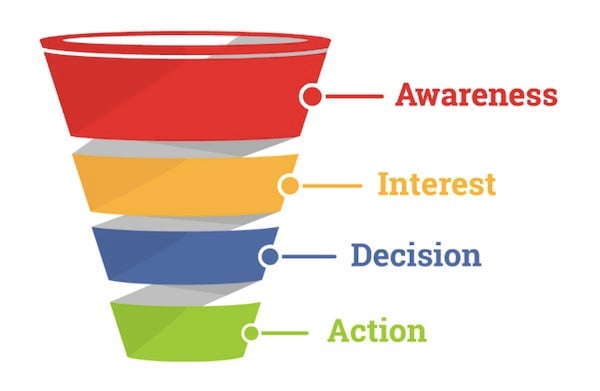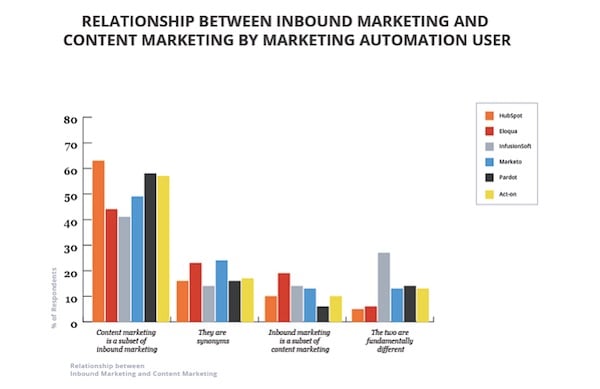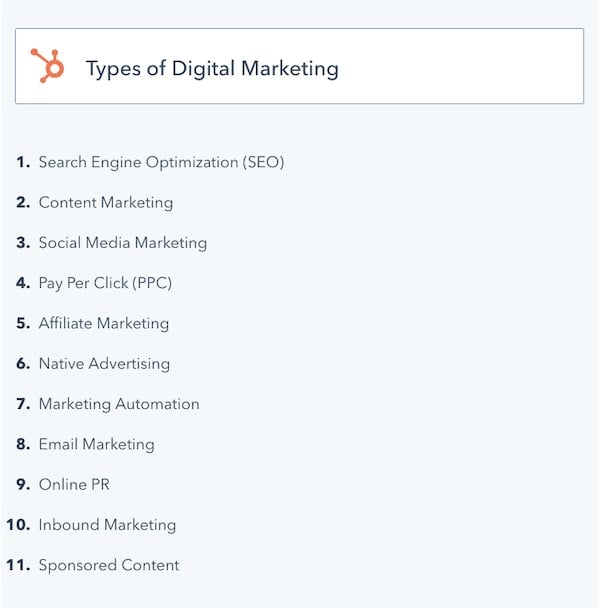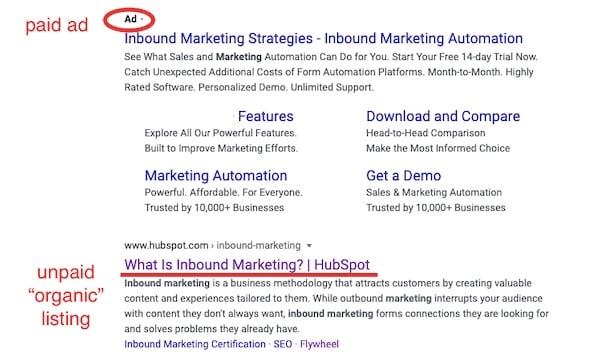You’ve probably heard terms like “inbound marketing,” “content marketing,” and “digital marketing” tossed around but didn’t know precisely what they meant or the methodology behind those strategies.
In this article, we’re going to dig into what inbound marketing is, how it works, and how it differs from traditional or “outbound” marketing.
TABLE OF CONTENTS
- What is the inbound methodology?
- Inbound marketing vs. content marketing vs. digital marketing
- Pros and Cons of inbound marketing
- Conclusion
What is the inbound methodology?
What is inbound marketing?
Let’s start with a nutshell definition:
Inbound marketing: a marketing style that aims to generate brand awareness and lasting client relationships by targeting audiences that actively need your products or services and providing them with resources and support that helps them achieve their goals.
So, at its core, inbound marketing is about finding audience members who are most likely to become your customers and helping them solve their problems.
Inbound primarily uses digital channels like search engines or social media, unlike traditional marketing, which frequently uses TV and print as well as digital channels.
But the differences between inbound and traditional or “outbound” marketing are deeper than the channels they use.
Inbound vs outbound marketing
“Out” bound marketing uses techniques that project your message out to your audience, often interrupting what they are doing to get their attention.
Examples of outbound marketing:
- Advertisements on TV, radio, billboards, the web, & in print
- Cold calling
- Direct mail
- Mass emails
This audience is often broader than the audiences that inbound targets, including many people who don’t need your product or service.
According to Forbes, “digital marketing experts estimate that most Americans are exposed to around 4,000 to 10,000 ads each day.”
Since this advertising is both irrelevant and annoying to many of the people who see it, people have resorted to a variety of methods to block them:
- Ad blockers
- “Skip ad” offers
- No-call list
- Email filtering
- Throwing away direct mail unopened
- Banner blindness
“In” bound marketing uses techniques that draw your target audience into your website, social media accounts, or other marketing channels by offering them valuable content that helps them solve their problems.
Examples of inbound marketing, according to HubSpot:
- SEO strategy
- Content targeting specific buyer personas at particular sales funnel, or “buyer’s journey” stages
- Inbound sales calls
- Helpful surveys
- Social media listening
Inbound also targets the segments of your audience who are more likely to be customers rather than casting a broad net, generally resulting in higher-quality leads.
Inbound methodology also prioritizes customer retention, encouraging customers to promote your company to people they know, generating more leads.
Key inbound marketing takeaways
Inbound isn’t interruptive. To deliver their messages, traditional advertising often interrupts what potential customers are doing, such as watching a TV show. Inbound marketing instead offers helpful content that potential customers find themselves.
- It is primarily a digital strategy. While inbound includes a few offline methods, like inbound sales calls, most inbound marketing takes place online or on electronic devices. Traditional advertising, on the other hand, often takes place offline.
- It targets the segments of an audience who are most likely to become customers. Traditional advertising often targets a broad audience, while inbound methods market to those who are most likely to need your business’s products or services.
- It focuses on long-term, sustainable results over short-term wins. Inbound’s emphasis on building positive relationships with customers is designed to help retain customers over time, and encourage them to recommend your company to others, but this can take time.
For example, strategies like SEO often take more time to generate results than a short ad campaign. Still, SEO can generate steady leads over a period of months or even years. That said, inbound does offer short-term benefits as well.
How inbound marketing works
Inbound marketing has three main stages: attract, engage, and delight.
Attract: Marketers build brand awareness and position themselves as an authority on particular topics in their industry to generate leads.
Common strategies, according to HubSpot:
- Relevant, helpful content: blog or social media posts, videos, guides
- Search engine optimization: optimizing content and your website to make it easier to find
- Ads: non-interruptive advertising that offers your readers valuable information
Engage: Marketers “nurture” leads by providing more advanced content, answering questions, and positioning themselves as a solution provider to encourage potential customers to make a purchase.
Common strategies, according to HubSpot:
-
Inbound sales calls: answering a potential client’s calls or following up after they reach out to you
-
“Solution selling”: selling solutions vs. products
-
Chatting with customers online: answering questions & providing prompt support during a potential client’s decision-making process
Delight: Marketers provide excellent support and customer service to help customers achieve their goals in the hopes that customers will continue their business relationship and recommend their products and services to others.
Common strategies, according to HubSpot:
- Chatbots and live chat: providing fast support on your customer’s timetable
- Feedback surveys: asking your client for feedback that can help you serve them and others better
- Social listening: keeping track of what people are saying about you online and responding quickly and graciously to feedback
For those who are familiar with the traditional sales funnel, these stages roughly correspond to the top, middle, and bottom of the funnel.

Source: Mailmunch
But not quite. HubSpot decided to replace the traditional sales funnel (above) with the flywheel model (below) to explain the inbound marketing process.
Source: HubSpot
If you're wondering whether this is the same sales funnel in a different shape, it's not. The sales funnel represents the outbound lead generation process, pre-internet. The flywheel represents how inbound lead generation works.
So how are they different? The traditional sales funnel is pretty linear. It takes you from the time a customer first interacts with your company to the time they make a purchasing decision. After they make a purchase, they shoot out the bottom of the funnel and are gone.
Inbound, on the other hand, is cyclical.
The flywheel takes the buyer from first interaction to purchase, just like the funnel, but instead of disappearing, that buyer sticks around.
Plus, a few of them are likely to tell their friends or business contacts how great you are. Since 88% of people trust recommendations from friends and family, this can bring in some great leads.
You can also accelerate the cycle, or slow it down. HubSpot terms this as “force” and “friction.”
You can add force to the wheel by putting strategies into place that retain or acquire customers.
Friction, on the other hand, happens when something interferes with your strategy, whether that’s poor communication between marketing and sales or website limitations. These issues will need to be resolved to keep the wheel turning at a steady clip.
The flywheel and B2B sales cycles in 2023
Another reason why HubSpot uses the flywheel rather than the funnel: It reflects today's internet-heavy, social buying process.
A study by Heiman Group in 2018 found that over 70% of B2B buyers already know what they need before contacting a sales representative.
The authors go on to say that one of the best ways to stand out as a potential vendor is to offer a perspective that competitors lack, and that “B2B sellers must adjust by bringing insights and expertise into the sales process.”
In other words, buyers could enter your sales cycle as consideration, or even decision-stage buyers with their wallets out.
You’ll want to meet them where they’re at, rather than giving them the same sales pitch as the awareness-stage buyers who aren’t sure what they need.
Plus, as Big Commerce points out, “74% of B2B buyers report researching at least half of their work purchases online.”
That means that producing search engine optimized content for buyers at different stages that showcases your expertise could be a major asset for B2Bs seeking to stand out from the competition and catch the eye of potential clients Googling services like theirs.
Review sites also hold a lot of power over a business’s reputation.
93% of consumers are influenced by reviews when making a buying decision, and 92% of B2Bs are more likely to purchase after reading a review they trust. This makes proper reputation and citation (online listing) management essential.
The linear, traditional funnel was not designed to account for buyers who already know what they want when they want it, or to take advantage of happy customers promoting you on review platforms.
That’s why a more cyclical, buyer-focused model better represents the buying process, or “buyer’s journey” of a 2023 customer.
Inbound marketing vs. content marketing vs. digital marketing
Inbound marketing vs Content marketing
 Source: HubSpot
Source: HubSpot
Different names for similar or related digital marketing strategies is another potential source of confusion.
According to HubSpot, the general consensus by inbound marketing users is that content marketing is a subset, or strategy, of inbound marketing.
Although, some surveyed also thought that content marketing might be synonymous with inbound, or that inbound is actually a subset of content marketing.
According to the Content Marketing Institute, however, content marketing has been around for over a hundred years.
Joe Pulizzi also mentions two examples of print content marketing still published today: LEGO’s LEGO Club Magazine, and the Ritz Carlton magazine.
The Content Marketing Institute defines content marketing as:
“a strategic marketing approach focused on creating and distributing valuable, relevant, and consistent content to attract and retain a clearly defined audience — and, ultimately, to drive profitable customer action.”
So, maybe it would be better to say that both are established marketing approaches and content marketing is one of the key strategies employed by inbound marketing.
Both inbound marketing and content marketing aim to provide value to potential and existing customers through relevant, useful content in the hopes that it will generate leads.
However, inbound content marketing typically combines the appeal of content marketing with SEO and customer-pleasing strategies to create digital content that can be used to acquire and retain customers.
Traditional content marketing also uses print. As a result, it may not always target highly specific audiences or involve SEO.
Digital marketing vs. inbound marketing
 Source: HubSpot
Source: HubSpot
Here’s how HubSpot defines digital marketing:
“Digital marketing encompasses all marketing efforts that use an electronic device or the internet. Businesses leverage digital channels such as search engines, social media, email, and other websites to connect with current and prospective customers.”
So, digital marketing is the generic term for marketing strategies conducted online and on electronic devices.
Inbound marketing, on the other hand, is conducted almost entirely online. I say almost, because there are exceptions.
For example, if a potential customer is drawn to your site through inbound content and decides to give your business a call, this is still considered inbound marketing, because they were attracted by your relevant content and chose to call you out of genuine interest.
This is different from outbound cold calling, where you interrupt a potential customer who may or may not be interested with a sales offer that may or may not be relevant.
Inbound marketing also doesn’t include methods such as interruptive banner ads online, as Lucy Alexander points out, even though banner ads are a type of digital marketing.
Inbound marketing then, might be considered a type of digital marketing, but the terms are not synonymous.
See real examples of inbound-powered marketing strategies →
Pros and Cons of inbound marketing
To wrap up, let’s look at some benefits and downsides of inbound marketing.
Cons of inbound marketing
- Takes time: Inbound marketing is a front-heavy marketing strategy that aims for steady, long-term results.
To get the inbound marketing machine to work, you need to set up processes, goals, and software, build relationships with potential customers to earn their trust, establish your brand as an industry authority, and write high-quality content. - Requires a high degree of expertise: Inbound strategies like search engine optimization or web design are complex disciplines that take years to master.
As a result, professionals who are already busy running their businesses or marketers in small organizations already juggling too many roles may find it challenging to squeeze in time to learn & implement inbound marketing themselves. - High-maintenance: Inbound marketing requires a lot of maintenance and strategy.
New content must be written and published regularly, and messages from current and potential customers need to be answered.
Your website, social media profiles, and business listings need to be kept accurate and up-to-date. Reviews need to be managed. New keyword and competitor research needs to be conducted. It takes work to do inbound well.
For a more detailed analysis, check out this article by Zoho, which makes many of the points above and breaks down the pros and cons of inbound by business size.
Pros of inbound marketing
- Quality leads: “Persona-driven content generated by inbound increases the volume of Sales Qualified Leads (SQLs) by 45%.” (LinkedIn).
Buyer personas (fictional characters that represent a segment of your target audience) help you write content that is aligned with the needs of the people who need and want your products or services.
Writing content that answers the questions of potential buyers helps buyers searching for answers online find you. Plus, helpful, well-written content helps earn their trust and keep you top of the mind. - Less expensive leads: “Inbound marketing costs 62% less per lead than traditional outbound marketing.” (HubSpot)
A company can spend a lot of money in inbound marketing if they choose, but inbound marketing uses mostly digital strategies, like content marketing, social media marketing, and SEO, that can be performed quite cheaply.
Content can be published for free on your own website or on a free social media account. Great search engine optimization helps people find this content in unpaid, “organic” search engine results.
 Source: Google
Source: Google
- Better conversion rate on your website: “Inbound marketers double the average site conversion rate, from 6% to 12% total.” (Intechnic)
Search engine optimization is crucial for making your website easy to find online, because it helps your pages rank well in search results.
Search engine optimization, combined with user-friendly design, high-quality development, and strong web copy make your website a pleasing and safe digital storefront.
Outdated design, poor site security, slow loading speed, or confusing website navigation all have the potential to drive visitors away.
Inbound content marketing done well can also increase the volume of potential customers visiting your website. This is because potential customers may see helpful, SEO content published on your website appear in their search results, and visit your site as a result. - Easy-to-track results: Because inbound marketing is conducted online, it’s easy to use analytics software like Google Analytics to track key performance metrics like conversions, or views to identify aspects of your strategy that aren’t working.
- Less annoying: Inbound marketing at its best is mutually beneficial for the business and potential customer. Rather than interrupting what the customer wants to do, inbound helps them accomplish their goals.
The customer gets helpful advice and great service when they want it. The business may generate better ROI and positions their brand as an authority.
Conclusion
Inbound marketing is a long-term strategy that takes time to implement and requires a team of highly skilled marketers familiar with SEO, content marketing, web design, development, social media marketing, email marketing, and inbound advertising to pull off well.
This can pose a challenge for B2Bs unfamiliar with digital marketing.
But, in the last decade or so, the inbound marketing methodology has proven to be generally more effective, less expensive, more sustainable, more pleasant for customers, and more profitable than traditional marketing methods.
Depending on your situation, this could make inbound methodology a wiser investment for your marketing dollars.
Topics: Sales & Marketing Strategies







